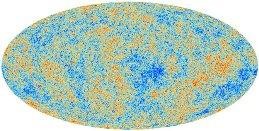A team of astrophysicists from the Inter-University Centre for Astronomy and Astrophysics (IUCAA) in Pune have made significant contributions to a joint mission of European Space Agency (ESA) and NASA, which revealed the most refined picture yet of the early cosmic history of the Universe today (March 21, 2013).
The CMB as observed by Planck. The CMB is a snapshot of the oldest light in our Universe, imprinted on the sky when the Universe was just 380 000 years old. Credit: ESA
According to ESA, the young Universe was filled with a hot dense soup of interacting protons, electrons and photons at about 2700ºC. When the protons and electrons joined to form hydrogen atoms, the light was set free. As the Universe has expanded, this light today has been stretched out to microwave wavelengths, equivalent to a temperature of just 2.7 degrees above absolute zero.
This CMB shows tiny temperature fluctuations that correspond to regions of slightly different densities at very early times, representing the seeds of all future structure: the stars and galaxies of today.
"The extraordinary quality of Planck's portrait of the infant Universe allows us to peel back its layers to the very foundations, revealing that our blueprint of the cosmos is far from complete," says Jean-Jacques Dordain, ESA's Director General.
The IUCAA team involved in the project:(clockwise from top) Sanjit Mitra, Aditya Rotti & Tarun Souradeep.
"The correction for complicated oddities of the instrument response has been critical for accurate estimation of key cosmological results from Planck the data", the release said. The Indian team worked in collaboration with the US Planck team at the Jet Propulsion Laboratory, California Institute of Technology.
This is the first release of results from cosmic microwave background measurements by Planck. The next major release of such results, which will include the full data set and further refinement in the analyses, is expected in 2014.
The Indian team will continue to contribute towards this effort, the release said.
